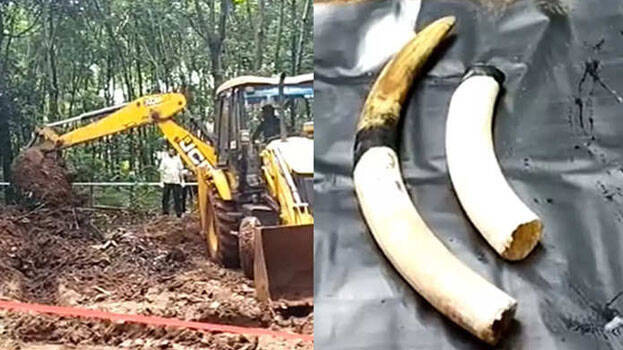

The body of a wild elephant was found buried in a rubber plantation in Kerala. This incident highlights the existence of criminal gangs in the forest and the harm caused to wildlife by traps and fences. The public is often unaware of such incidents but those affected by wild animal disturbances understand the need for action.
Investigation revealed that the elephant was killed for its tusks. The body of a 15-year-old elephant was uncovered with one of its tusks cut off. The flesh had decayed completely leaving only bones behind. The body had been buried for more than 20 days. It seems a chemical was used to speed up the decomposition. The owner of the rubber plantation, Maniyanchira Roy has been missing since the incident. The forest department received information that Roy paid a team from Pala to help bury the elephant's body.
It was found that the stolen tusk had been given to another group from Marayoor. Akhil Mohan, who was caught trying to sell the ivory provided this information. The forest department suspects the involvement of several individuals with ten people currently facing charges. Roy, the plantation owner is the main accused and is considering surrendering to the court with his friend. The charges are serious and bail might not be granted under the Wildlife Act of 1972.
Electric shock to kill, harsh chemical to decompose body
The forest department's initial findings indicate that the elephant was electrocuted. A strong chemical was used to decompose the body quickly. The exact chemical used is yet to be determined through tests. The criminals knew that the ivory wouldn't decay even if buried for a long time. They likely planned to remove the tusks after the flesh had completely decomposed. The investigation has led authorities from Kodanadu to Mullurkara, where a machete used to cut the tusk was found. Around 14 cm of the tusk had been removed and the accused deny using any other chemicals.
Efforts to catch the culprits involve four teams led by the Machadu Range Officer. Individuals involved in the illegal ivory trade are under surveillance and searches are intensifying, focusing on those previously involved in elephant poaching. This incident highlights the increasing presence of elephant poachers and ivory smugglers in Kerala.
Wildlife disturbance used as cover
The plantation owner Roy, owns rubber plantations and agricultural land where wild animals often cause problems. The forest department suspects that hunting activities are masked as measures to control wildlife disturbances. The burial site was a common landing area for many wild animals. Areas such as Kakkanikad, Akamala, Attur, Vazhakode, Melillam, Kalappara, Vazhani, Thonnurkara, and Asurankundu have witnessed frequent visits from wild animals, resulting in significant damage to plantation crops. This incident highlights the increasing use of traps and snares to kill wild elephants.